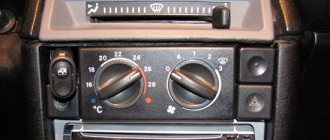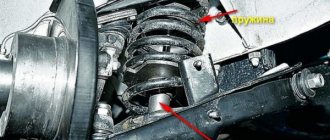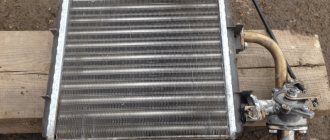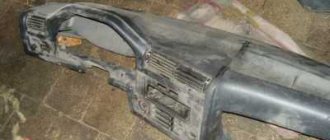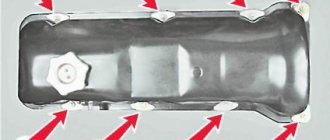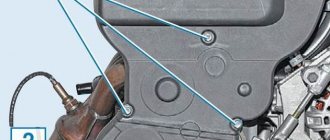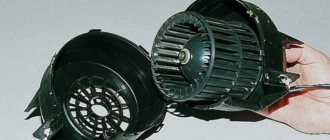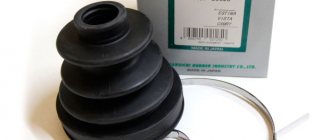VAZ 2107 heater valve injector: heater modification
In our country, driving a car with a faulty heater in winter is strictly not recommended. This rule is true for all cars, and the VAZ 2107 is no exception. The fact is that the heater of this car has never been reliable and has always caused car owners a lot of trouble. And the heater valve, which began to leak literally a year after buying the car, gained especially notoriety among owners of “Sevens”. Fortunately, you can replace this part yourself. Let's figure out how to do this.
PURPOSE AND PRINCIPLE OF OPERATION OF THE OVEN VALVE ON THE VAZ 2107
In short, the purpose of the stove tap is to give the driver the opportunity to switch between “summer” and “winter” modes of heating the interior. To understand what we are talking about, you need to understand how the heating system of the “seven” works.
The fuel taps on all “sevens” without exception were membrane valves
So, the VAZ 2107 engine is cooled by antifreeze circulating in the so-called jacket. Antifreeze passes through the jacket, picks up heat from the engine and heats up to a boil. This boiling liquid must be cooled somehow. To do this, antifreeze is directed through a system of special pipes from the jacket to the main radiator, which is continuously blown by a massive fan.
The 7 engine cooling system has two radiators: the main one and the heating one.
Passing through the main radiator, the antifreeze cools and goes back into the engine for the next cooling cycle. The radiator (which in the early “sevens” was made exclusively of copper) becomes very hot after antifreeze passes through. And the fan, which continuously blows on this radiator, creates a powerful flow of hot air. In cold weather, this air is directed into the cabin.
In addition to the main radiator, the “seven” has a small heating radiator. It is on this that the heating tap is installed.
The heating valve on the “seven” is attached directly to the stove radiator
In winter, this tap is constantly open, so that hot antifreeze from the main radiator goes to the stove radiator, heating it too. The small radiator has its own small fan, which supplies heated air directly into the car’s interior through special air lines.
The heating system of the “seven” has its own fan and a complex system of air ducts
In summer there is no need to heat the interior, so the driver closes the heating tap. This makes it possible to use a heating fan without heating the interior (for example, for ventilation, or when the windows are fogged up). That is, a heating tap is necessary to quickly switch between small and large antifreeze circulation circles in the “seven” heating system.
Inoperative heater valve VAZ 2107 and other malfunctions - signs
Basically, malfunctions of the heating system are associated with the failure of the control unit, sensors or actuators (dampers, taps, fan elements). This could be an open or shorted circuit. In addition, malfunction is often the result of prolonged and improper use, as a result of which some elements are affected by corrosion.
You can understand that this system is faulty based on a number of signs. Most likely, the temperature regime will be disrupted, and difficulties will arise with regulating the air flow. Another sign that you can look for is that the fan motor does not make sounds. It is also possible that liquid that is poured into the cooling system may leak. At the same time, it is quite difficult to determine from such external symptoms what exactly is the cause of the breakdown.
COMMON FUEL VALVE FAULTS
All malfunctions of the fuel valve on the VAZ 2107 are in one way or another related to a violation of the tightness of this device. Let's list them:
- The fuel valve started leaking. It’s impossible not to notice: a large puddle of antifreeze forms under the feet of the passenger sitting in the front seat, and a characteristic chemical smell spreads throughout the car’s interior. As a rule, a leak occurs due to the fact that the membrane in the fuel tap has become completely unusable. This is usually observed after two to three years of operation of the crane;
- The fuel valve is stuck. It's simple: the diaphragm fuel valve mentioned above is susceptible to oxidation and corrosion. Almost all drivers in our country close this tap in the warm season. That is, at least three months a year the tap remains in the closed position. And these three months are quite enough for the rotary rod in the faucet to oxidize and become firmly “stuck” to the body of the device. Sometimes it is possible to turn such a rod only with the help of pliers;
- antifreeze leaking from under the clamps. On some “sevens” (these are, as a rule, the latest models), the valve is attached to the pipes with steel clamps. These clamps weaken over time and begin to leak. And this is perhaps the most minor problem with the fuel tap that a car enthusiast may encounter. To solve it, simply tighten the leaking clamp with a flat screwdriver;
- The faucet does not open or close completely. The problem is due to internal contamination of the device. It is no secret that the quality of antifreeze on the domestic market of fuels and lubricants leaves much to be desired. In addition, counterfeit coolant is also found (as a rule, antifreeze from well-known brands is counterfeited). If the driver is used to saving on antifreeze, then gradually the fuel tap becomes clogged with dirt and various chemical impurities, which are present in abundance in low-quality antifreeze. These impurities form hard lumps that do not allow the driver to turn the valve stem all the way and completely close (or open) it. In addition, low-quality antifreeze can cause rapid corrosion of the internal parts of the standard "seven" diaphragm valve, and this can also prevent the fuel valve from being tightly closed. The solution to the problem is obvious: firstly, remove and thoroughly rinse the clogged tap, and secondly, use only high-quality coolant.
VARIETIES OF FUEL TAPS
Since the fuel tap on the VAZ 2107 is an extremely short-lived device, after two years of operation of the tap the driver will inevitably face the question of replacing it. However, fuel taps vary in both reliability and design. Therefore, it is worth understanding them in more detail.
MEMBRANE TYPE VALVE
A membrane-type valve was installed on all “sevens” that ever came off the assembly line. It is very easy to find this crane for sale: it is available in almost every spare parts store. This part is inexpensive - only 300 rubles or so.
The membrane heating valve on the “seven” has never been reliable
But the car owner should not be tempted by the low cost of a membrane tap, since it is very unreliable. And literally in two or three years the driver will again see coolant leaks in the cabin. Therefore, you should set the diaphragm fuel valve to “seven” only in one case: if the car enthusiast has not found anything more suitable.
FUEL BALL VALVE
A ball fuel valve is a more acceptable option for installation on a VAZ 2107. Due to its design features, a ball valve is much more reliable than a diaphragm valve. The shut-off element in ball valves is a steel sphere with a small through hole in the middle. This sphere is attached to a long rod. And this entire structure is built into a steel body, equipped with two pipe threads. To open the tap, it is enough to turn its stem 90°.
The main element of the ball valve is the steel locking sphere
With all the advantages, the ball valve has one significant drawback, which makes many drivers refuse to buy it. The sphere in the tap is steel. And although faucet manufacturers claim that these spheres are made only of stainless steel, practice shows that in aggressive antifreeze they very easily oxidize and rust. Especially during the long summer downtime, when the tap is not opened for several months. But if the driver is forced to choose between a diaphragm valve and a ball valve, then, of course, he should choose a ball valve. The price of ball valves today starts from 600 rubles.
TAP WITH CERAMIC ELEMENT
The most reasonable solution when replacing the fuel tap on a VAZ 2107 would be to purchase a ceramic tap. Externally, this device is practically no different from a ball and diaphragm valve. The only difference is in the design of the locking element. It consists of a pair of flat, tightly fitted ceramic plates placed in a special sleeve. This sleeve has a hole for the rod.
Ceramic tap - the best option for the VAZ 2107
When the rod turns, the distance between the plates increases, opening the way for antifreeze. The advantages of a ceramic faucet are obvious: it is reliable and not subject to corrosion. The only drawback of this device is the price, which can hardly be called affordable and starts at 900 rubles. Despite the high price, the driver is strongly recommended to purchase a ceramic faucet. This will allow you to forget about antifreeze leaking into the cabin for a long time.
WATER TAP
Some drivers, tired of constant problems with the standard “Seven” fuel tap, solve the problem radically. They go not to the auto parts store, but to the plumbing store. And they buy an ordinary water tap there. Usually this is a Chinese ball valve for pipes with a diameter of 15 mm.
Some drivers install regular water taps on the VAZ 2107
Such a faucet costs 200 rubles maximum. After this, the standard diaphragm valve from the “seven” is removed, a hose is passed into the niche where it stood, and a fuel valve is attached to the hose (it is usually secured with steel clamps, purchased at the same plumbing store). This design lasts a surprisingly long time, and in case of corrosion and jamming, the procedure for replacing such a tap takes only 15 minutes. But this solution also has a drawback: the water tap cannot be opened from the cabin. Every time the driver wants to use the heater, he will have to stop the car and climb under the hood.
Speaking about water taps, I can’t help but recall one story that I personally witnessed. A driver I know installed a Chinese crane under his hood. But he categorically did not want to jump out into the cold every time to open it. He solved the problem in the following way: he slightly expanded the niche in which the standard faucet had previously been located using ordinary metal scissors. He drilled a hole on the handle that opens the water tap. He inserted a hook made from an ordinary long knitting needle into this hole. He brought the other end of the spoke into the salon (under the glove compartment). Now, in order to open the tap, he just had to pull the knitting needle. Of course, such a “technical solution” cannot be called elegant. However, the man still solved the main task - not to climb under the hood every time.
What is a car heater radiator
Almost every car is equipped with an interior heating system, in which one of the main elements is the radiator. Thanks to this part, heat is collected from the coolant and subsequently supplied to the passenger compartment.
Where is the heater radiator installed on the VAZ 2104–2107 and what functions does it perform?
The heater radiator on all classic Zhiguli cars is located in a special box under the front panel. The product is a heat exchanger, the main function of which is to transfer heat from the coolant (antifreeze) with subsequent distribution throughout the cabin. This unit works in the same way as the main radiator of the power unit. For the stove to function correctly, the heat exchanger must be constantly heated. This is achieved by connecting the radiator to the engine cooling system using tubes and rubber pipes and constant circulation of liquid through a water pump (pump).
The heater radiator on the “classic” is located in a special box under the front panel
IMPORTANT NUANCES
There are a couple of important nuances that should not be forgotten when installing a new fuel tap. Here they are:
- A new faucet always comes with several rubber gaskets. They must be installed without fail, even if it seems that the gaskets of the old faucet are practically not worn out and will still serve. The fact is that standard VAZ tires, from which old gaskets are made, last a year, or two at most. After this, microcracks appear in it, which are impossible to see with the naked eye. But gradually the network of cracks grows, and the tap begins to leak again. Therefore, installing new gaskets on the tap is mandatory;
- The second point is related to the operation of the crane lever. Before closing the hood, be sure to check whether this lever works well. More precisely, whether the length of the cable is well adjusted, and whether this cable allows you to fully open and close the tap. It often happens that the old cable after installing a new tap turns out to be half a centimeter shorter, as a result of which the tap cannot close completely due to the tension of the cable. If such a picture is observed, you should remove the fastening tip, loosen the nut on it, and pull out a little cable from it (usually there is a reserve of a couple of centimeters in the tip). After this, the tip should be put back on the tap lever and check whether the tap closes tightly;
- The third point is related to checking the tightness. Before closing the hood after installing the faucet, you should open the new faucet, then start the engine and let the car run for half an hour. During this time, the antifreeze will have time to heat up. If the tightness is broken somewhere, an antifreeze leak will occur, which will be difficult to miss. If no leaks are observed after running the engine for half an hour, the procedure for installing a new faucet can be considered complete.
So, even a novice car enthusiast can change the fuel tap on the “seven”. This does not require any special knowledge or skills. You just need to have a basic understanding of the design of the VAZ 2107 heating system and strictly follow the above recommendations.
How to replace a crane on a VAZ 2101-2107 “classic”, “Volga”, “Niva”, “Oka” (work order)
The operations for replacing the heater valve on different cars are very similar and differ mainly in the need to dismantle some parts to gain access to the failed valve.
Note: the heater faucet from the Zhiguli also fits the Volga, Niva, and Oka cars.
Next, we will consider in detail the replacement of the tap on VAZ 2101-07 “classic” cars.
According to the instructions, before proceeding with the removal of the pipes, it is necessary to drain the liquid from the engine cooling system. This operation can be omitted, given the fact that the stove radiator and pipes are located above the level of the main radiator. It should be taken into account that some of the coolant will still leak out, so you need to have a small container on hand.
Use a screwdriver to loosen the clamps and remove the hoses from the heater radiator pipes. Do not forget to place a container under the hoses to drain the coolant leaking from the pipes.
Using a key “8”, unscrew the two screws and remove the seal from the radiator pipes.
In the car interior, remove the instrument panel shelf. For convenience, remove the glove box body. On VAZ 2104, 2107 with an instrument panel with side air ducts, it is also necessary to dismantle the air duct by unscrewing the nut to “10” and prying the latches around the perimeter with a slotted screwdriver.
Using a key set to “7”, loosen the screw and disconnect the heater tap drive rod (1).
Removing the stove tap
Using a “10” wrench, unscrew the two nuts securing the valve to the heater radiator (2) and remove the heater valve along with the inlet pipe and rubber gasket.
Using a “10” wrench, unscrew the two nuts and disconnect the inlet pipe with the gasket from the tap. Pay attention to the gasket profile.
We remove and replace the drive rod mounting bracket on the new faucet.
Advice: it is better to replace “old” metal hose clamps with new reinforced ones (blue).
We install a new faucet with new gaskets in the reverse order of removal. To be on the safe side, we apply sealant to the joint surface between the faucet and the radiator, as well as the faucet and the inlet pipe.
Installing a new heater tap
We fill the engine cooling system with liquid (if it is completely drained) or add some of the liquid that leaked from the pipes and radiator during replacement, and make sure that the connection between the valve and the heater radiator and the inlet pipe is tight.


